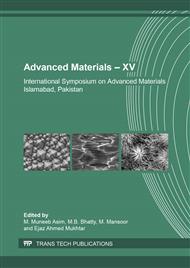[1]
M. Moniruzzaman, K.I. Winey, Polymer nanocomposites containing carbon nanotubes, Macromolecu., 39 (2006) 5194-5205.
DOI: 10.1021/ma060733p
Google Scholar
[2]
H. Ma, L. Tong, Z. Xu, Z. Fang, Synergistic effect of carbon nanotube and clay for improving the flame retardancy of ABS resin, Nanotechnol., 18 (2007) 375602.
DOI: 10.1088/0957-4484/18/37/375602
Google Scholar
[3]
M.A. Atieh, Effect of Functionalized Carbon Nanotubes with Carboxylic Functional Group on the Mechanical and Thermal Properties of Styrene Butadiene Rubber, Fuller. Nanotub. Carbon Nanostruct., 19 (2011) 617-627.
DOI: 10.1080/1536383x.2010.504953
Google Scholar
[4]
N. Iqbal, S. Sagar, M.B. Khan, H.M. Rafique, Ablation, thermal stability/transport and mechanical investigations of modified nanokaolinite impregnated acrylonitrile butadiene rubber composites, J. Comp. Mater., 48 (2013) 1221-1231.
DOI: 10.1177/0021998313484948
Google Scholar
[5]
J.K. Park, T.J. Kang, Thermal and ablative properties of low temperature carbon fiber–phenol formaldehyde resin composites, Carbon. 40 (2002) 2125-2134.
DOI: 10.1016/s0008-6223(02)00063-5
Google Scholar
[6]
N. Iqbal, S. Sagar, M.B. Khan, M.I. Bassyouni, Z.M. Khan, Aluminum silicate fibers impregnated acrylonitrile butadiene rubber composites: Ablation, thermal transport/stability, and mechanical inspection, J. Appl. Poly. Sci., 130 (2013) 4392-4400.
DOI: 10.1002/app.39717
Google Scholar
[7]
S.S. Iqbal, F. Inam, A. Bahadar, M.A. Bashir, F. Hassan, M.B. Khan, Z.M. Khan, T. Jamil, Ablation, thermal stability/transport/phase transition study of carbon nanofiber-reinforced elastomeric nanocomposites, J. Therm. Analy. Calorim., (2017).
DOI: 10.1007/s10973-017-6831-1
Google Scholar
[8]
S. Sagar, N. Iqbal, A. Maqsood, U. Javaid, Thermogravimetric, differential scanning calorimetric and experimental thermal transport study of MWCNT/NBR nanocomposites, J. Therm. Analy. Calorim. 114 (2013) 161-167.
DOI: 10.1007/s10973-013-2949-y
Google Scholar
[9]
N. Iqbal, S. Sagar, M.B. Khan, Comprehensive ablation characteristics of ceramic fibers impregnated rubber composites, Intern. J. Eng. Technol., 6 (2014) 162-167.
DOI: 10.7763/ijet.2014.v6.688
Google Scholar
[10]
S.S. Iqbal, N. Iqbal, T. Jamil, A. Bashir, Z.M. Khan, Tailoring in thermomechanical properties of ethylene propylene diene monomer elastomer with silane functionalized multiwalled carbon nanotubes, J. Appl. Poly. Sci., 26 (2015) 232-239.
DOI: 10.1002/app.43221
Google Scholar
[11]
S. Sagar, N. Iqbal, A. Maqsood, Multiwalled carbon nanotubes impregnated rubber nanocomposites: thermal transport/decomposition and differential scanning calorimetric study, J. Reinfor. Plast. Compo., 32 (2013) 1052-1061.
DOI: 10.1177/0731684413484184
Google Scholar
[12]
N. Iqbal, S. Sagar, M.B. Khan, H.M. Rafique, Elastomeric ablative nanocomposites used in hyperthermal environments, Poly. Eng. Sci., 54 (2013) 255-263.
DOI: 10.1002/pen.23573
Google Scholar
[13]
F. Jamshaid, A. Ahmad, M. Adrees, S.S. Iqbal, H. Zaheer, T. Jamil, J. Ahmad, T. Hussain, Tuning the interlaminar shear strength and thermo-mechanical properties of glass fiber composites by incorporation of (3-mercaptopropyl) trimethoxysilane-functionalized carbon black, Iran. Poly. J., 11 (2017).
DOI: 10.1007/s13726-017-0576-3
Google Scholar


